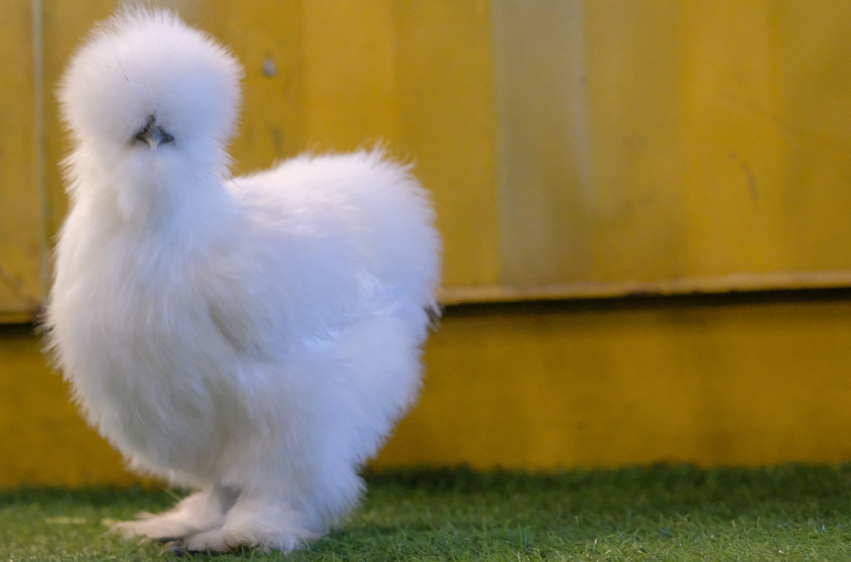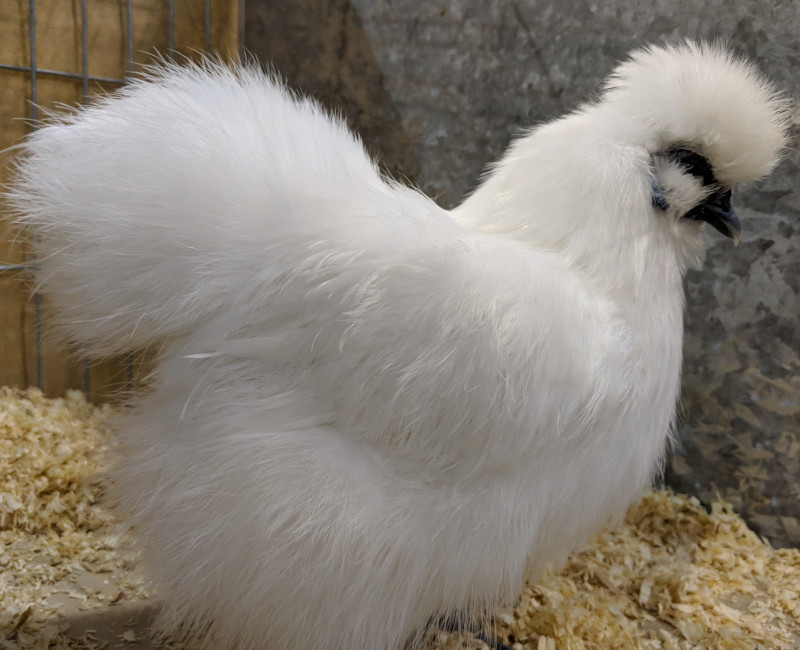Silkie breed standard.

This page will include the APA standard for the Bantam Silkie, some background history on them as well has how the points are set up on judging a Silkie at a show!
A Silkie must look broad and stout with a short back and rise to a short, round fluffy tail. The fluffy Silkie feathering should be abundant over the whole body with the wing feathers ragged. Silkies should have five toes and feathered feet and shanks and the skin should be black.
Below: A show quality Silkie.
What colours are allowed for Silkies?
Which colours you can exhibit depends on where you are. The colours are different between the US, the UK and Australia.
Black and white are always allowed in all the breed standards but check your local poultry club rules to see what colours you can exhibit.
What makes a Silkie show quality?
Show quality is so subjective it is easier to list the faults that Silkies should not have when breeding.
Below: Silkies should be even coloured, well marked and have a crest or beard if appropriate.

The legs and skin should be deep blue or black and there is an extra toe. Silkies should be only fluff with no hard feathers and must have feathery feet. The comb is walnut.
The shape and stance also go to make up how a bird is judged when shown.
Below: Here is a poultry judge watching how the chicken moves and stands.
The scale of points for judging Silkies:
- Type - 20 points - This is how the bird displays the features that make it a Silkie. It should be broad and stout and the back should be short and rise through to a short, rounded, fluffy tail. The body should be covered in abundant fluff and the wings ragged.
- Head - 30 points - The head must be short, tidy and topped with a crest which in the male will have shiny streamer feathers. The crest must allow the bird to see. The beak should be a slate grey or black in a black bird, short and neat and with black eyes. The comb should be a plum coloured walnut shape.
- Legs - 10 points - The legs should be short, straight and wide set. Well fluffed at the thigh and moderately feathered along the shank with no hard feathers. There should be 5 feathered toes with the fifth toe coming off of the fourth.
- Colour - 10 points - Silkie colours must be even and true to type with no yellow in the white.
- Plumage or feathers - 30 points - Plumage must be silky and fluffy throughout. There should be plenty of thick feathers which also cover the thighs and extend down the shanks and cover the middle and outer toes.
There should be a complete absence of hard feathering.
APA Standard Of Perfection for Silkie:
Feather Legged Bantams - Weights:
Cock 36 oz. Cockerel 32 oz.
Hen 32 oz. Pullet 28 oz.
Shape - Male and Female
Male comb - Walnut - set firmly and evenly on head, almost circular in shape, preferably broader than longer, with a number of small prominence's over it, a slight indentation or furrow, transversely across the middle, rising at a point just forward of the nostrils and extending backwards to a point parallel with the front of the eyes.
Female comb - Walnut, very small, well formed. Rest of the description same as the male.
Below: A well formed Silkie hen.

Beak: Short and stout, curving to a point.
Face: Surface smooth, skin fine and soft in texture.
Eyes: Large, round and prominent.
Wattles:
Male - Non-Bearded: medium size, concave, nearly round, fine in texture, free from wrinkles or folds. Bearded - very small, concealed by beard., natural absence preferred.
Female - Non-Bearded: small, concave, forming a half circle, fine texture, free from wrinkles or folds. Bearded: small to nonexistent, concealed by beard.
Ear-Lobes:
Male - Non-Bearded: small, oval, fine in texture, free from wrinkles or folds. Bearded: very small, almost concealed by muffs.
Female: very small, rest of description the same as the male.
Crest:
Male - medium size, soft and full. as upright as comb will permit, having a few silky feathers streaming gracefully backwards from lower and back part of crest.
Female: medium size, soft and full, globular, upright, well balanced.
Head:
Moderately small, short, carried so that a line drawn parallel with tip of the tail will bisect the comb.
Beard & Muffs:
Bearded varieties - thick, full, extending back of eyes and projecting from sides of face and composed of feathers turned horizontally backwards, from both sides of the beak, from the centre, vertically downwards, the whole forming a collar of three ovals in a triangular group, giving a muffed effect.
Neck:
Short, gracefully arched, with a very full hackle flowing well over the shoulders.
Back:
Male - short, broad from shoulders to saddle, quite rounded its entire length rising gradually from middle of the back towards tail.
Female - short, broad from shoulders to cushion, quite rounded its entire length, rising gradually from middle of back towards tail.
Saddle:
Male - Rising from back at base of cape, very broad and round, plumage profuse and long, lower saddle feathers flowing over tips of wings and mingling with fluff.
Cushion:
Rising from back at base of cape, very broad and round, plumage abundant.
Tail:
Male - short, very shredded at ends, well spread at base, filled underneath with an abundance of soft feathers which are overlapped by coverts and lesser sickles, the whole forming a duplex curve with back and saddle. Sickles, lesser sickles, and coverts - abundant, soft, well curved, without hard quills, concealing main tail feathers.
Female - short, very shredded at ends, well spread at base, filled underneath with an abundance of soft feathers which are overlapped by cushion and coverts, the whole forming a duplex curve with back and cushion.
Wings:
Medium size, closely folded, carried well back and nearly horizontal, well above the lower thighs ending short of stern. Shoulders and fronts: concealed by hackles and breast feathers. Bows and coverts: Very well rounded. Primaries: medium length, well shredded, tapering convexly to stern, tips concealed by saddle feathers.
Breast:
Carried forward, very full, well rounded and of great depth and width.
Body And Fluff:
Body of moderate length, broad, deep and well rounded from breast bone to stern and let down well between the legs.
Legs and Toes:
Legs short and stout, set well apart, straight when viewed from the front. Lower thighs: short, stout at top, tapering to hocks, abundantly feathered.
Hocks:
Covered with soft and silky feathers curving inwards about the hocks.
Shanks:
Rather short, stout in boner, well feathered on the outer sides with silky plumage, the upper part growing out from thigh plumage and continuing into foot feathering. Spurs: medium size and length, set just above the 5th toe.
Toes:
Five, the three front straight, well and evenly spread, the hind toe double, the normal toe in natural position and the extra toe placed above, starting from close to the other toe, but well formed, longer than the other toes and curving upwards and backwards; the outer and middle toe well feathered.
Female - same as male except no spur. (Bare middle toe a serious defect in either sex)
